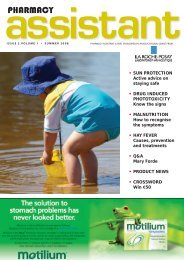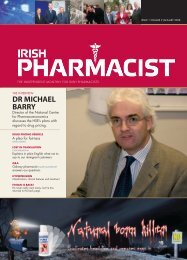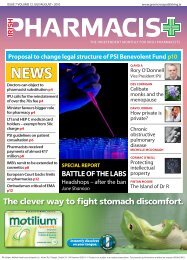veNTIlATIoN - Green Cross Publishing
veNTIlATIoN - Green Cross Publishing
veNTIlATIoN - Green Cross Publishing
Create successful ePaper yourself
Turn your PDF publications into a flip-book with our unique Google optimized e-Paper software.
probiotics<br />
36<br />
Part 4<br />
deIrdre JordAN bsc ANutr (SCIENCE OFFICER, yAKULT IRELAND)<br />
lINdA v ThomAs bsc Phd FIFsT (SCIENCE DIRECTOR, yAKULT UK LTD)<br />
There is now a reasonable body of evidence to<br />
indicate that certain probiotic strains may help<br />
support the immune system and, in general, the<br />
body’s natural defences. In this four part series<br />
on probiotics we have looked at the evidence for<br />
probiotics (i) as a risk reduction measure against antibioticassociated<br />
diarrhoea and Clostridium difficile infection; (ii)<br />
in reducing the effects of irritable bowel syndrome and<br />
associated symptoms, and more recently (iii) in the general<br />
health benefits of probiotics for the elderly. A fundamental<br />
aspect of regular probiotic consumption is their modification<br />
of the intestinal microflora such that numbers of beneficial<br />
bacteria are maintained or increased, and the effects or<br />
numbers of harmful or pathogenic bacteria are decreased. This<br />
is associated with a range of positive effects on the health and<br />
functioning of the digestive system, as well as modulation of<br />
immune function. 1 Probiotics can also have many related and<br />
more specific modes of action. By supporting the beneficial<br />
bacteria in the commensal flora, they may help inhibit the<br />
growth and reduce any harmful effects of other bacteria,<br />
antigens, toxins and carcinogens in the gut. In addition,<br />
and very importantly, probiotics can influence the immune<br />
system via the gut-associated lymphoid tissue, with positive<br />
modulation reported for the innate and even the acquired<br />
immune system (Box 1).<br />
The gut is the most vulnerable site in the body, which is<br />
why the majority of the immune system is based there in the<br />
form of the gut-associated lymphoid tissue (Figure: GALT).<br />
The small intestine contains hundreds of Peyer’s patches<br />
(concentrations of lymphoid tissues), but lymph nodes are<br />
found through the whole length of the gut (in fact, 85% of<br />
the body’s lymph nodes are estimated to be in the gut). This<br />
immune network must recognise and tolerate the commensal<br />
microflora (otherwise inflammation results), and it must also<br />
tolerate food antigens. But importantly, it must recognise and<br />
deal with pathogenic microbes. Studies with germ-free animals<br />
have clearly shown that the commensal microflora is important<br />
in educating and supporting the immune system; animals<br />
without any gut bacteria have a poorly developed immune<br />
The immune<br />
system and<br />
your gut:<br />
a closer look at an<br />
intricate relationship<br />
(Part 4 of a 4 part series)<br />
system with significantly fewer antibody-producing cells.<br />
Probiotics can support the work of the commensal flora<br />
in interacting and supporting the immune system, which<br />
explains why certain probiotics have been shown to benefit<br />
the health of the whole body, not just that of the gut.<br />
box 1: Innate and acquired immune system<br />
• The innate or non-specific immune response<br />
defends the host from infection in a non-specific<br />
manner. Cell surface receptors (Toll-like receptors)<br />
on tissue recognise and bind different microbial<br />
components. This can trigger phagocytosis and<br />
production of pro-inflammatory cytokines, which<br />
attract a local increase in white blood cells. The innate<br />
immunity is an immediate response but it does not<br />
confer long-lasting or protective immunity. Example<br />
constituents of this system are natural killer (NK)<br />
cells and phagocytic cells such as neutrophils and<br />
macrophages. Examples of Toll-like receptors are TLR-4<br />
(recognises lipopolysaccharide, the cell wall of Gramnegative<br />
bacteria) and TLR-9 (recognises bacterial<br />
DNA).<br />
• The acquired/adaptive or specific immune<br />
response recognises and remembers specific<br />
pathogens and is thus able to mount a rapid and<br />
stronger defence when the pathogen is next<br />
encountered. Lymphocytes (T and B cells) recognise<br />
specific and different parts of a pathogen, and then<br />
can activate different pathways against it. Humoral<br />
immunity is an antibody-mediated specific response<br />
by B cell production of immunoglobulins (antibodies)<br />
such as IgA, IgG and IgE. (Humoral refers to the bodily<br />
fluids and comes from the old idea of ‘humors’ of the<br />
body). The other response is cell-mediated, mainly<br />
involving antigen-specific T cells.










